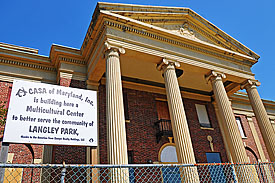
For a few students, Langley Park’s most important landmark is actually not the Tick Tock liquor store.
Tucked away just behind the building, fewer than two miles from the campus, lies an old, decaying, vandalized mansion that has been unoccupied for decades. But with the help of a Gemstone research team, the McCormick-Goodhart Mansion will become a Langley Park community center. The project could mark a turning point in improving the university’s somewhat standoffish relationship with this low-income, predominantly immigrant neighborhood.
One of the members of the research group, Allison Wilson, decided she wanted to work to improve Langley Park during her freshman year, after taking the honors seminar “Just a Mile Away: The Langley Park Neighborhood and the Making of a New America.”
“When I saw the building, I was inspired because it’s a great piece of architecture,” the architecture major said.
But her interests quickly switched to social activism. The group of eight Gemstone students is surveying Langley Park residents to determine how the community center could meet the needs of the local population, which is 72 percent foreign-born.
Bill Hanna, who teaches the Langley Park seminar, lauded the Gemstone group’s endeavors, saying a large community space in Langley Park would help lower crime and high school drop-out rates – which he estimated at roughly 50 percent.
Jennifer Freedman, the director of development for CASA of Maryland – the non-profit immigrant advocacy group which recently acquired the mansion – was thrilled when Wilson first offered the team’s assistance.
“It was a great match. We’re always excited to work with the university,” Freedman said. “We needed a lot of help. We were just getting started.”
The Gemstone team will report its findings to CASA of Maryland, which announced plans to renovate the mansion last October. CASA of Maryland hopes to begin construction on the renovations this summer and have the community center ready by fall 2009, Freedman said.
Although the Gemstone group members maintain it’s too early to draw conclusions from the roughly 200 surveys they have conducted at Langley Park health fairs, church services, supermarkets and other locations, CASA of Maryland has already put together plans for the community center’s programs. Freedman said the mansion will provide legal and health services, computer training, English classes, leadership development programs and economic development programs, in addition to becoming the headquarters for CASA of Maryland and other local minority advocacy groups.
Maj. Kevin Davis, the commander of District 1 for the Prince George’s County Police Department, which includes Langley Park, said tackling the community’s pervasive social issues helps reduce crime. The community center will provide a place for immigrants, particularly illegal immigrants, to seek government services without fear of police involvement, Davis said.
“It is important for us to remember there are a lot of cultural barriers that immigrants confront,” Davis said. “CASA will serve as that middle man to get people who are very, very vulnerable the help they need.”
CASA of Maryland’s executive director Gustavo Torres, while very appreciative of the Gemstone team’s work, said he would still like to see more effort from the university to address the needs of Langley Park.
“I believe that the University of Maryland is making a good contribution to this process and we are very excited about that. But I do believe there is huge room to improve,” Torres said. “We really want to partner with the University of Maryland and bring all the resources that they have to Langley Park. We are five minutes from the university, and it’s a great opportunity for the University of Maryland to partner with communities.”
Hanna, who said he uses Langley Park as a laboratory in teaching the honors course devoted to Langley Park each spring semester, agreed with Torres’ assessment.
“I guess there are a fair number of school kids [in Langley Park] who have some idea that there is a University of Maryland, but it’s more of a separate world I think,” Hanna said. “I think more and more we should have resources in Langley Park,” he said, adding that he wrote a letter to the provost this week calling for funding to set up programs in the university’s surrounding neighborhoods.
But it remains unclear how many students are aware of Langley Park’s needs or even its existence.
“The disparity between wealth, education, background and just a lack of information that there is out there is just outstanding,” Wilson said. “University of Maryland students need to care because [Langley Park] is a part of our community. We tend to live in a bubble on this campus. It’s not just about us.”
The McCormick-Goodhart Mansion itself, located on 15th Street off of University Boulevard, is surrounded by fence, with wooden boards where glass windows once stood. The remnants of illegible, scratched-off graffiti are still visible on the sides of its stone rear deck. The building stands at the center of an apartment complex that holds 587 low-income units, and it is just a short walk away from 1,500 additional low-income homes.
This central location’s potential to aid Langley Park citizens was not lost on Wilson.
“We’re hoping to create some kind of concrete impact on a town, on a community,” Wilson said.
And Torres remains optimistic that the university’s link to Langley Park will remain strong in years to come.
“I really appreciate everything the students are doing because they are so dedicated and investing a lot of time and energy in producing the report. It is just the beginning of our partnership with the University of Maryland,” Torres said.
penndbk@gmail.com



